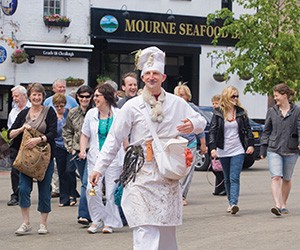From “Breakfast Month” in January to this month’s “Love Dairy” to “Christmas & Premium Foods” in December, 2016 is Northern Ireland’s Year of Food and Drink, as the province celebrates 366 leap year days of award-winning cuisine, produce, spirits and other bounty.
Attracting more than £350 million (more than USD$505 million) annually in visitor spending, the culinary riches range from Belfast Bap, the crusty round bread that sustained thousands during the Potato Famine of the mid-18th century, to Bushmills whiskey, founded in 1608. With artisanal producers helping to drive awareness (and exports), some 70 Northern Ireland companies garnered nearly 200 gold stars in the 2015 Great Taste Awards, the Oscars of the U.K. culinary world.
“I believe there is significant room for further growth,” states Terence Brannigan, chairman of Tourism Northern Ireland. “We have some of the best produce, the best chefs and the best restaurants in the world and the potential this has when it comes to tourism cannot be underestimated.”
Boasting nine Michelin-starred restaurants, the Republic of Ireland has an equally persuasive culinary tale. Belfast-born John McKenna, writer of the award-winning McKennas’ Guides with wife Sally, calls this “the most exciting time in Irish food, ever.” Served with classic Irish hospitality, here are just a few tastes of the rewarding gastronomy awaiting groups.
Epicurean Excellence
Signifying Northern Ireland’s culinary rise are two newly Michelin-starred restaurants, Ox and Eipic, both in Belfast.
Trained in Michelin-starred Parisian kitchens, Belfast-born chef-owner Stephen Toman opened Ox in 2013 with friend and sommelier Alain Kerloc’h. Vegetables, seafood and “seasonal creativity” star in Toman’s colorful, earthy, sustainably sourced cuisine, which earned a Michelin star in 2015, the first for Northern Ireland in five years.
With large windows overlooking the River Lagan, the 40-seat restaurant includes secluded mezzanine space for 10, while hosting tastings, events and private parties for up to 50 at the adjacent Ox Cave wine bar. Groups of seven or more get the ever-changing “surprise” tasting menu, while theater-going guests can return for the equally inspiring desserts after the show.
Toman sources fresh produce from Ballywalter Park in Newtownards, about 19 miles east of Belfast. Built between 1846 and 1870, the Italianate Palazzo-style main house, with nine double and two twin bedrooms, is available exclusively for corporate and incentive groups, overnights and buyouts included. Set on 1,200 acres, the estate is the home of Lord Brian Mulholland, the 6th Baron Dunleath, and his Danish-born wife Lady Vibeke Dunleath. Mulholland’s ancestors acquired the property in 1848, and it is currently available for cultural and historical tours as well as film shoots.
“Following pioneers such as Myrtle Allen, famed for her early approach to locally sourced, sustainable Irish country cooking at Ballymaloe House in County Cork and her Ballymaloe Cookery School, the Irish culinary scene has been much transformed over the last decade,” says Lady Dunleath, a food historian who oversees event catering for groups, including dinners based on century-old menus from the house.
“Regional, sustainable and seasonal are today’s buzzwords in Ireland, where the benign climate allows us to grow practically anything,” she continues, describing everything from the harvest of the seas, such as locally caught langoustines (prawns) and the fresh fruit, salads and vegetables grown in Ballywater’s walled garden and Victorian glasshouses.
Naming Ox as her personal favorite, she also acknowledges the “amazing” transformation of Belfast’s culinary scene.
“Our chefs are young and mostly classically trained, which makes them both creative and inventive,” Lady Dunleath says. “Belfast Food Tours is one option for groups, while Mourne Seafood Bar and James Street South are among several restaurants offering cookery classes and private dining.”
Eipic, from serial restaurateur Michael Deane, earned Northern Ireland’s other Michelin star last year. (Deane previously won, then lost, a star at his former Deanes, where Ox’s Alain Kerloc’h once worked). Named in honor of pleasure-seeking epicureans, his fine-dining return to glory is helmed by chef Danni Barry, whose Michelin win makes her only the second woman chef in Ireland to earn the honor.
Private dining space is available at all of Deane’s Belfast concepts, including the Meat Locker and Love Fish.
Belfast Bred is an entertaining foodie walking tour narrated by fictional Titanic chef “Barney,” who leads groups on his quest for ingredients to recreate the ill-fated ship’s launch menu. Highlights include Belfast’s historic St George’s Market, one of the U.K.’s top food markets.
Halfway between Belfast and Londonderry, the acclaimed restaurant at Ardtara Country House offers private dining for up to 20 guests. Southeast of Belfast in Lisbane, the award-winning Poacher’s Pocket gastro-pub hosts private dining and functions.
In the Republic of Ireland, Dublin’s five Michelin-starred restaurants include perennial favorite L’Ecrivain. Opened in 1989, this culinary charmer also offers private cooking demonstrations and two private rooms for 12 to 20 people. Chef-owner Derry Clarke was previously head chef at Michelin-starred Le Bon Appetit in coastal Malahide just north of the city, which specializes in intimate gatherings for up to 65 people.
An hour from Dublin in Ireland’s 5,000-year old Ancient East region, standouts include Michelin-starred Lady Helen, one of several dining venues at the Mount Juliet estate.
Culinary Connections
From pasture-raised beef and lamb and fresh-caught seafood and shellfish to uniquely creamy dairy products, Ireland’s renown for top-class ingredients is no secret. The hand-churned butter from Northern Ireland’s Abernethy Butter, for example, is all the rage among leading chefs and establishments in Ireland and England.
Yet, it took the collective effort of determined chefs, restaurateurs and artisanal producers to create the recent culinary renaissance—and visionaries like Margaret Jeffares to develop a viable food tourism industry.
In 2006, Jeffares, herself a farmer and food producer, founded Good Food Ireland (www.goodfoodireland.ie) as a commercial vehicle for uniting Ireland’s agricultural, tourism and hospitality industries. Under her leadership, Good Food Ireland has since blossomed into an Ireland-wide destination management organization offering diverse off-the-shelf and customized programs such as culinary tours, incentives, teambuilding opportunities and showcase events with top chefs and producers for groups from 20 to 20,000 people.
“Deeply rooted in its culture, landscapes and people, Ireland’s vibrant food scene creates a unique sense of place,” Jeffares says. “Visitors encounter food with a strong local connection and sense of legacy, while increasing on-farm diversification amongst primary producers has led to a wealth of new artisan food produce. It is this depth of farm-to-fork experience and ‘discoverability’ that Good Food Ireland highlights and showcases to the world.”
Representing the brand standard for premium, authentic Irish culinary experiences, Good Food Ireland’s 600-plus members, ranging from farmers and fishermen to hotels, restaurants, pubs and cooking schools, means a feast of options for groups.
These include Arbutus Bread in Cork (founded by Declan Ryan, who won Ireland’s first Michelin star in 1971); Dublin’s Aqua Restaurant, featuring winning seafood and seaside views; Dingle Cookery School on Kerry’s rugged coast; and culinary adventures along the Causeway Coast or Wild Atlantic Way.
No Irish experience is complete without a drink or more. Originated in 1759, Guinness stout, one of the world’s most iconic beer brands, is a must at any pub, or via tours of Dublin’s event-capable Guinness Storehouse at the brewer’s original St. James Gate location. Named for the small Northern Ireland village where it was founded in 1608, Bushmills, this island’s oldest working distillery, offers tastings and tours.
Featured festivals in Northern Ireland’s Year of Food and Drink include the famed Hillsborough International Oyster Festival and Bushmills Salmon & Whiskey Festival, both in September; Food & Drink Show Northern Ireland, at the Titanic Exhibition Centre in October; and Belfast Beer and Cider Festival in November. Slainte!







